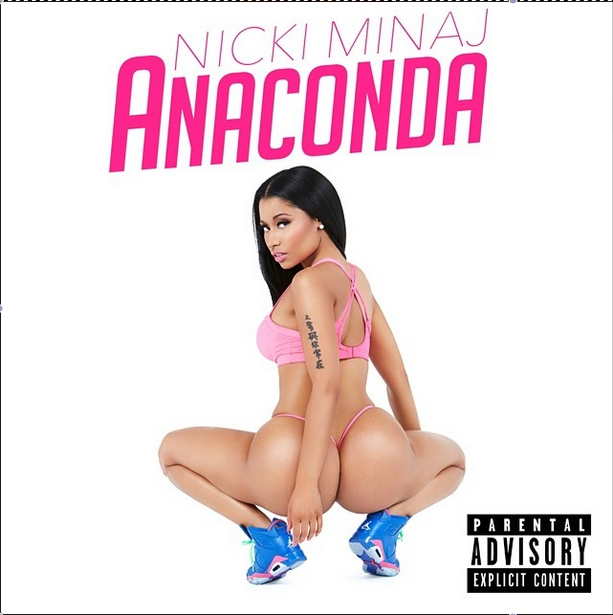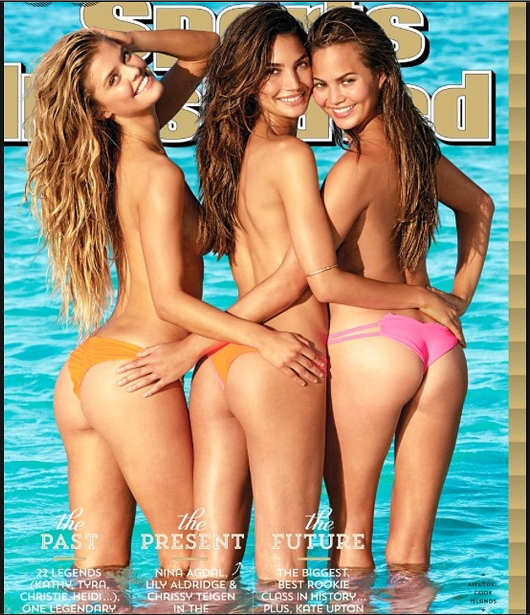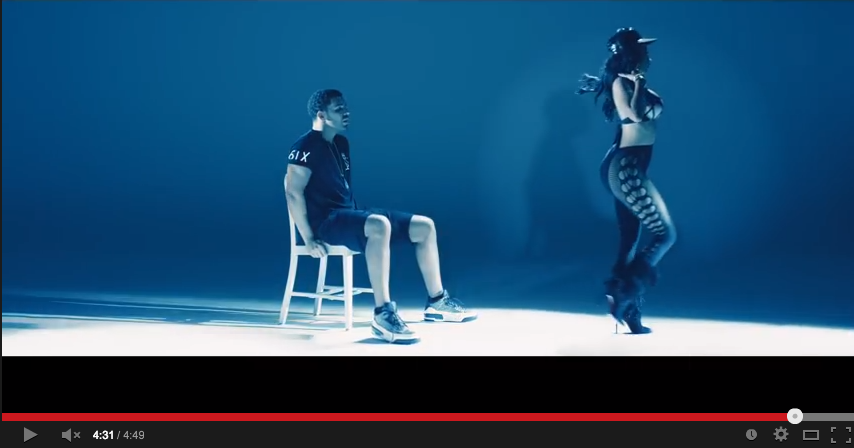September 28, 2014 - 23:52

Gabrielle Smith
Critical Feminist Studies
Anne Dalke
28 September 2014
My Anaconda Don't Want Your Normative Feminist Standards
“Oh, my, god. Becky, look at her butt.
It is so big.
She looks like one of those rap guys' girlfriends.
But, you know, who understands those rap guys?
They only talk to her, because, she looks like a total prostitute, 'kay?
I mean, her butt, is just so big.
I can't believe it's just so round, it's like, out there, I mean— gross. Look!
She's just so... black!”
Baby Got Back music video: https://www.youtube.com/watch?v=kY84MRnxVzo#t=12
This is the Intro to Sir Mix-A-Lot’s “Baby Got Back” It was a song written to commemorate the black body. Sir Mix-A-Lot stated in an interview with Billboard “women with curves were not accepted.” He said his song was not meant as a political statement, but he wanted “curvy” women to not be ashamed about their bodies. (Horowitz) However, the music video has faced some criticism for objectifying women. The video is full of scantily clad women who are dancing in a very provocative way. The video highlights the women’s backsides, with Sir Mix-A-Lot pointing and making commentary, while he is fully clothed ("Sir Mix A Lot Baby Got Back Best Quality").It is very voyeuristic. Sir Mix-A-Lot wants these women should be proud that they have a big behind. He reduces the entirely of these women’s worth to the size of their body.
Although the entire point of “Baby Got Back” is to objectify women, it was done with good intentions. Sir Mix-A-Lot was trying to fight for the rights of curvy women to show and love their bodies. In 1992 it was relevant for Sir Mix-A-Lot to include, as the intro to his song, two white women talking, and demonizing body of a black woman. The women who Becky and her friend are talking about, who star in the rest of the “Baby Got Back” music video, are compared to prostitutes, and are called “gross.” During this monologue we see the black woman showing off her body in a sexual way. And in the end, Becky sums all this up by saying that the women are “so black” ("Sir Mix A Lot Baby Got Back Best Quality"). The idea that black women are “wrong” or “gross” when they express themselves in a sexual way is still perpetuated today.

(Kaufman)
Anaconda music video: https://www.youtube.com/watch?v=LDZX4ooRsWs
Nicki Minaj received a lot of criticism for the album cover of her latest single, “Anaconda,” pictured above, for the way she showed her body. The picture is extremely provocative, with Nicki wearing nothing over her g-string. Combating the criticism on Twitter, Nicki posted the cover of her album again, with the caption ”Unacceptable.” Then she posted a picture of a Sports Illustrated cover, which had three slim white women who are wearing less clothing than Nicki, with the caption “Angelic. Acceptable. Lol” (Kaufman)

(Kaufman)
Nicki's tweets give us context of what it means to be a black woman. While society sees it as wrong when black women show off their bodies, it is okay as long as you are white.That does not stop Nicki. The music video for her song “Anaconda” is even more provocative that the cover photo. Nicki and her backup dancers are wearing minimal clothing and dancing in a way that is very focused on evoking a sexual response ("Nicki Minaj - Anaconda").
Taking that into consideration, I think Sir Mix-A-Lot and Nicki had the same purpose with their songs, and they went about it in a very similar way. They are not encouraging assimilation. In no way are Sir Mix-A-Lot or Nicki Minaj trying to support black women by saying that they should be treated just like white women. Sir Mix-A-Lot does not try to tell Becky and her friend that the black women are just like them. And Nicki, at the end of her song, Nicki distinguished herself and other curvy women from slim women. Both Sir Mix-A-Lot and Nicki Minaj come out on top because they don’t ascribe the worth of black women to white women. They also don’t give worth to curvy women by comparing them to slim women. The In these ways the videos are identical, which seemed to be done by Nicki on purpose. Her video resembles “Baby Got Back,” both lyrically and visually. The difference comes from who is saying the message.
I think it is really important to distinguish why “Baby Got Back,” though well intentioned, was inappropriate, while Anaconda isn’t. In the context of a contact zone, Sir Mix-A-Lot is in the privileged group. He is a man in a male dominated field. And because he has power in this way, Mix-A-Lot takes away the autonomy of the women in his video, instead of giving them autonomy. His involvement in the video creates a dynamic where the women’s value is reliant on him, instead of themselves. This is just a virtue of him being there, not a virtue of his intentions. Nicki’s video does not have the same problem, because she is able to define her worth without a man. The only man who appears in the video is Drake, another rapper, who plays a very passive role. Nicki gives him a very sexual lap dance, while Drake just sits there. When he tries to engage with Nicki, she slaps his hand and struts away. It is undeniable that she is in charge (Rios). Because of this, Nicki can be objectified on her own terms. The problem with objectification is not that it reduces somebody’s worth to their physical appearance, because it is human nature to do that at some point of a relationship. The problem is when it is not on the terms of the person being objectified.

("Nicki Minaj - Anaconda")
Nicki Minaj used her music video as contact zone to get her point across. As a female rapper, she is definitely among the minority in the rap world. She has to fight harder to get recognized and respected. So far Nicki has acquired the praise that would dictate that she is one of the best in the rap world. And she used the same tools that normally hinder women to empower them. Mary Louise Pratt defines contact zones as “social spaces where cultures meet, clash, and grapple with each other, often in contexts of highly asymmetrical relations of power.” Within contact zones, there is a privileged group and an underprivileged group, which creates the power dynamic. However, while in the zone, the underprivileged group can use the tools of the privileged group to benefit themselves. (Pratt 34-35) It a way it is like speaking the privileged group’s language. In this context, the form of communication was a rap and its video, instead of something like a scholarly article. And in this communication Nicki subtly made it clear that her body belonged to her, and that the male gaze is unwanted, even though she behaves in the same manner that we see in other rap videos, like “Baby Got Back” (Rios).
It is not Nicki Minaj’s responsibility to be the spokesperson for all black women with her body type. She is one of the few prominent female rappers in the industry, and therefore has a sort of spotlight shone on her. However, she only has a responsibility to represent herself in the manner she wishes people will see her. Often times, when representing people in art, there is difficulty in representing them ethically. When an artist is representing somebody in one image, they have a responsibility to portray their subject in a way that the subject wants. That can be tricky when the artist is not the subject, because it is impossible, as two different people, to think the same thoughts and have the same feelings. And especially when the subject is a part of a marginalized group, there is also an emphasis placed on the social justice aspect of representation, because “all representations have social and political consequences” (Garland-Thomson 75).
Because Nicki is both the subject and the artist, the ethics of representation don’t apply to her in the same way. Does the way she represent herself still have consequences? Yes. And as I said before, Nicki made her points in a very subtle way. Because of that I suspect that more people will miss her message than get it. But it should not be Nicki’s responsibility to make society understand her message. Sir Mix-A-Lot, however, had a responsibility to not perpetuate the act of objectifying women, even if a woman asked him to. Because he does not identify as a curvy woman of color, he cannot reclaim objectification in this way. Nicki Minaj is in a point of contention between being a woman, being black, being curvy, and being a rapper. Yet she does a beautiful job of using the last of those identities to reclaim the first three.
Works Cited
Horowitz, Steven J. "Sir Mix-A-Lot on Nicki Minaj's 'Anaconda,' Booty Fever & New Music." Billboard. Billboard, 12 Sept. 2014. Web. 28 Sept. 2014.
Kaufman, Scott. "Rapper Nicki Minaj Strikes Back at Critics Calling Her New Album Cover Too Raunchy." Raw Story. N.p., 2 Aug. 2014. Web. 28 Sept. 2014.
"Nicki Minaj - Anaconda." YouTube. YouTube, 19 Aug. 2014. Web. 27 Sept. 2014.
Pratt, Mary Louise. "Arts of the Contact Zone." JSTOR. N.p., n.d. Web. 28 Sept. 2014.
Rios, Carmen. "Nicki Minaj's Feminism Isn't About Your Comfort Zone: On "Anaconda" and Respectability Politics." Autostraddle. The Excitant Group, 25 Aug. 2014. Web. 28 Sept. 2014.
"Sir Mix A Lot Baby Got Back Best Quality." YouTube. YouTube, 18 Sept. 2009. Web. 28 Sept. 2014.
Snyder, Sharon L., Brenda Jo Brueggemann, and Rosemarie Garland-Thomson. "The Politics of Staring: Visual Rhetorics of Disability in Popular Photography." Disability Studies: Enabling the Humanities. New York: Modern Language Association of America, 2002. N. pag. Print.

Comments
Minaj Feminism
Submitted by Anne Dalke on October 4, 2014 - 16:55 Permalink
Sunshine—
We had talked, a few classes back, about Jack Halberstam’s new work on “Gaga Feminism”; I think you’re doing something similar, gesturing toward a form of “Minaj Feminism” (a project that students in earlier versions of Critical Feminism have also taken on; you might find both Redesigning Setting the Scene and Mein Musics of interest).
The bottom line of your project—that “Baby Got Back” was inappropriate, while “Anaconda” isn’t—makes it sound more like a review than a critical analysis of Minaj’s performance, as does your final statement that she does a “beautiful job” of
reclaiming her identity. So I’m interested in pushing you further into analysis, asking you to clear up some of the spots where I find myself confused. On the one hand, you place Minaj in a “contact zone”; on the other, you say that it’s “not Nicki’s responsibility to make society understand her message.” (What’s the contact zone, if not a site for making contact, for making oneself understood?) On the third hand, you say that, in the zone, “the underprivileged group can use the tools of the privileged group to benefit themselves.” (What isn’t clear to me here is the relationship between benefiting the self and engaging in cultural translation.)
The videos are so explicit, and yet you insist that the message—that Minaj’s body belongs to her—is a “subtle” one. Subtle how? Finally, you say that “because Nicki is both the subject and the artist, the ethics of representation don’t apply to her in the same way.” This is really where I am most curious about the terms of your argument. I’d like to hear much more about what it means to “represent yourself” (is this Minaj representing herself, or some stereotype?), and whether you think that there are any limits on this, limits imposed by the artist’s immediate viewers or by more general social norms (am thinking again, of course, of that Confederate flag on campus). You claim for Minaj the act of self-objectification, and I of course get the larger claim (this one made by that earlier critical feminist) that “she turns the viewers’ judgments back on them”: “Actively placing herself in the role of a sexual temptress…Minaj makes the intervention that women too, are interested in optimum sexual prowess and can take power or ‘money’ and ‘residuals’ from men with the tool of her sexuality. Her ‘ass’ or sexuality is her power and she is in control.”
But I’d like to see you relocate those claims within the framework of this course: what does Minaj’s assertion of sexual prowess tell us about intersectionality? About the “ethics of representation” in the “transitional spaces” that are our institutions? Is it ‘ethical’ to reverse power relations (but not subvert them? or do you see this as subversion?), to represent oneself as sexually powerful? And what are the social implications of doing so?